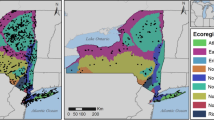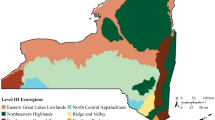Abstract
We reviewed literature reporting both total and methylmercury from biota from Acadia National Park, Maine, USA. Our review of existing data indicates that 1) mercury contamination is widespread throughout the Park’s various aquatic ecosystems; 2) mercury pollution likely represents a moderate to high risk to biota inhabiting the Park; and 3) biota at all trophic levels possess elevated concentrations of both total and methylmercury. Watershed fire history and the resulting post-fire forest succession patterns are an important landscape attribute governing mercury cycling at Acadia National Park. Therefore, park service personnel should consider these factors when planning and implementing Hg biomonitoring efforts. Additional baseline funding from the National Park Service for Hg research and biomonitoring will likely be required in order to further evaluate the spatial and temporal patterns of mercury contamination in the park’s biota.
Similar content being viewed by others
References
Bank, M., Loftin, C., & Amirbahman, A. (2004). Mercury bioaccumulation in green frog and bullfrog tadpoles from Acadia National Park, Maine, United States Geological Survey Technical Report.
Bank, M. S., Loftin, C. S., & Jung, R. E. (2005). Mercury bioaccumulation in Northern two-lined salamanders from streams in the Northeastern United States. Ecotoxicology, 14(1–2), 181–191.
Bonzongo, J., Heim, K., Warwick, J., & Lyons, W. (1996). Mercury levels in surface waters of the Carson River – Lahontan Reservoir System, Nevada: Influence of historic mining activities. Environmental Pollution, 92, 193–201.
Bowerman, W., Evans, E., Geisy, J., & Postupalsky, S. (1994). Using feathers to assess risk of mercury and selenium to bald eagle reproduction in the Great Lakes region. Archives of Environmental Contamination and Toxicology, 27, 294–298.
Burgess, J. (1997). Mercury contamination in fishes of Mount Desert Island: A comparative food chain mercury study, Masters thesis, Department of Zoology, University of Maine, Orono, Maine, USA, 58 pp.
Burgess, N., Evers, D., Kaplan, J., Duggan, M., & Kerekes, J. (1998). Mercury and reproductive success of Common Loons breeding in the Maritimes. In Mercury in Atlantic Canada: A progress report (pp. 104–109). Environment Canada – Atlantic Region, Sackville, New Brunswick.
Calhoun, A., Cormier, J., Owen Jr., R., Roman, C., O’Connell, A., & Tiner, R. (1994). The wetlands of Acadia National Park and vicinity, U.S. Fish and Wildlife Service, National Wetlands Inventory, Newton Corner, Massachusetts, 108 pp.
Downs, S., MacLeod, C., & Lester, J. (1998). Mercury in precipitation and its relation to bioaccumulation in fish: A literature review. Water Air and Soil Pollution, 108, 149–187.
Evans, R., Addison, E., Villeneuve, J., Macdonald, K., & Joachim, D. (1998). An examination of spatial variation in mercury concentrations in otter (Lutra canadensis) in south-central Ontario. Science of the Total Environment, 213, 239–245.
Evans, R., Addison, E. Villeneuve, J., Macdonald, K., & Joachim, D. (2000). Distribution of inorganic and methylmercury among tissues in mink (Mustela vison) and otter (Lutra canadensis). Environmental Research, 84, 133–139.
Evers, D., Kaplan, J., Meyer, M. W., Reaman, P., Braselton, W., Major, A., et al. (1998). A geographic trend in mercury measured in Common Loon feather and blood. Environmental Toxicology and Chemistry, 17, 173–183.
Evers, D., Lane, O., & Savoy, L. (2003a). Assessing the impacts of methlymercury on piscivorous wildlife using a wildlife criterion value based on the Common Loon, 1998–2002, Report BRI 2003–09 submitted to the Maine Dept. Environ. Protection, BioDiversity Research Institute, Falmouth, Maine.
Evers, D., Taylor, K., Major, A., Taylor, R., Poppenga, R., & Scheuhammer, A. (2003b). Common Loon eggs as indicators of methylmercury availability in North America. Ecotoxicology, 12, 69–81.
Fitzgerald, W., Engstrom, D., Mason, R., & Nater, E. (1998). The case for atmospheric mercury contamination in remote areas. Environmental Science and Technology, 32, 1–7.
Gaines, K., Romanek, C., Boring, C., Lord, C., Gochfield, M., & Burger, J. (2002). Using raccoons as an indicator species for metal accumulation across trophic levels: A stable isotope approach. Journal of Wildlife Management, 66, 811–821.
Gilmour, C., & Henry, E. (1991). Mercury methylation in aquatic systems affected by acid deposition. Environmental Pollution, 71, 131–169.
Golet, W., & Haines, T. (2001). Snapping turtles (Chelydra serpentina) as monitors for mercury contamination of aquatic environments. Environmental Monitoring and Assessment, 71, 211–220.
Hintelmann, H., Harris, R., Heyes, A., Hurley, J., Kelly, C., Krabbenhoft, D., et al. (2002). Reactivity and mobility of new and old mercury deposition in a boreal forest ecosystem during the first year of the METAALICUS study. Environmental Science and Technology, 36, 5034–5040.
Jagoe, C. H., Bryan Jr., A., Brant, H., Murphy, T., & Brisbin Jr., I. (2002). Mercury in bald eagle nestlings from South Carolina, USA. Journal of Wildlife Diseases, 38, 706–712.
Johnson, K. B., Haines, T. A., Kahl, J. S., Norton, S. A., Amirbahman, A., & Sheehan, K. D. (2005). Controls on mercury and methylmercury deposition for two watersheds in Acadia National Park, Maine. Environmental Monitoring and Assessment, this volume.
Kamman, N., & Engstrom, D. (2002). Historical and present fluxes of mercury to Vermont and New Hampshire lakes inferred from Pb-dated sediment cores. Atmospheric Environment, 36, 1599–1609.
Kahl, J. S., Fernandez, I., Manski, D., Haines, T., & Lent, R. (2002). Study of atmospheric deposition effects on surface waters and watershed resources: Paired-gauged watershed research at Acadia National Park, USGS-BRD Technical Report, 13 pp.
Kahl, J. S., Nelson, S., Fernandez, I., Haines, T., Norton, S., Wiersma, G. B., et al. (2005). Streamwater chemistry integrates landscape factors in a paired watershed study at Acadia National Park, Maine, USA. Environmental Monitoring and Assessment, this volume.
Lacerda, L. (1997). Global mercury emissions from gold and silver mining. Water Air and Soil Pollution, 97, 209–221.
Lindqvist, O., Johansson, K., Aastrup, M., Anderson, A., Bringmark, L., Hovsenius, G., et al. (1991). Mercury in the Swedish environment – Recent research on causes, consequences and corrective methods. Water Air and Soil Pollution, 56, 1–261.
Lodenius, M. (1998). Dry and wet deposition of mercury near a chlor-alkali plant. Science of the Total Environment, 213, 53–56.
Longcore, J. R., Haines, T. A., & Halteman, W. A. (2005). Mercury in tree swallow food, eggs, bodies, and feathers at Acadia National Park, Maine, and an EPA Superfund site, Ayer, Massachusetts. Environmental Monitoring and Assessment, this volume.
Lucotte, M., Schetagne, R., Thérien, N., Langlois, C., Tremblay, A. (Eds.) (1999). Mercury in the Biogeochemical Cycle. Berlin Heidelberg New York: Springer, 334 pp.
Mason, R., Fitzgerald, W., & Morel, F. (1994). The biogeochemical cycle of elemental mercury: Anthropogenic influences. Geochimica et Cosmochimica Acta, 58, 3191–3198.
Mason, R., & Sullivan, K. (1997). Mercury in Lake Michigan. Environmental Science and Technology, 31, 942–947.
Meyer, M., Evers, D., Hartigan, J., & Rasmussen, P. (1998). Patterns of Common Loon (Gavia immer) mercury exposure, reproduction, and survival in Wisconsin, USA. Environmental Toxicology and Chemistry, 17, 184–190.
Mierle, G., Addison, E. M., MacDonald, K., & Joachim, D. (2000). Mercury levels in tissues of otters from Ontario, Canada: Variation with age, sex, and location. Environmental Toxicology and Chemistry, 19, 3044–3051.
Morel, F., Kraepiel, A., & Amyot, M. (1998). The chemical cycle and bioaccumulation of mercury. Annual Review of Ecology and Systematics, 29, 543–566.
Nelson, S. J., Johnson, K. B., Kahl, J. S., Haines, T. A., & Fernandez, I. J. (2005). Mass balances of mercury and nitrogen in burned and unburned forested watersheds at Acadia National Park, USA. Environmental Monitoring and Assessment, this volume.
NESCAUM (1998). Northeast states and eastern Canadian provinces: Mercury study: A framework for action. Boston, Massachusetts.
Parkman, H., & Meili, M. (1993). Mercury in macroinvertebrates from Swedish forest lakes: Influence of lake type, habitat, life cycle, and food quality. Canadian Journal of Fisheries and Aquatic Sciences, 50, 521–534.
Parks, J., & Hamilton, A. (1987). Accelerating recovery of the mercury-contaminated Wabigoon-English River system. Hydrobiologia, 149, 159–188.
Petranka, J. (1984). Ontogeny of the diet and feeding behavior of Eurycea bislineata larvae. Journal of Herpetology, 18, 48–55.
Pritchardt, P., Folt, C., Chen, C., Klaue, B., & Blum, J. (2002). Algal blooms reduce the uptake of toxic methylmercury in freshwater food webs. Proceedings of the National Academy of Sciences, 99, 4419–4423.
Rasmussen, P. (1994). Current methods of estimating atmospheric mercury fluxes in remote areas. Environmental Science and Technology, 28, 2233–2241.
Richardson, M., Mitchell, M., Coad, S., & Raphael, R. (1995). Exposure to mercury in Canada: A multimedia analysis. Water Air and Soil Pollution, 80, 21–30.
Stafford, C., & Haines, T. (1997). Mercury concentrations in Maine sport fishes. Transactions of the American Fisheries Society, 126, 144–152.
St. Louis, V., Rudd, J., Kelly, C., Beaty, K., Flett, R., & Roulet, N. (1996). Production and loss of methylmercury and loss of total mercury from boreal forest catchments containing different types of wetlands. Environmental Science and Technology, 30, 2719–2729.
Stebbins, R., & Cohen, N. (1995). A natural history of amphibians. Princeton, New Jersey: Princeton University Press, 332 pp.
Swain, E., Engstrom, D., Brigham, M., Henning, T., & Brezonik, P. (1992). Increasing rates of atmospheric mercury deposition in midcontinental North America. Science, 257, 784–787.
Thompson, D. (1996). Mercury in birds and terrestrial animals. In W. Beyer, G. Heinz, & A. Redmon-Norwood (Eds.), Environmental contaminants in wildlife: Interpreting tissue concentrations (pp. 341–355). Boca Raton, Florida: Lewis.
Tremblay, A., & Lucotte, M. (1997). Accumulation of total mercury and methylmercury in insect larvae of hydroelectric reservoirs. Canadian Journal of Fisheries and Aquatic Scieices, 54, 832–841.
Tremblay, A., Lucotte, M., & Rheault, I. (1996). Methylmercury in a benthic food web of two hydroelectric reservoirs and a natural lake of northern Quebec (Canada). Water Air and Soil Pollution, 91, 255–269.
USEPA (1997). Mercury study report to Congress. Volume VII: Characterization of human health and wildlife risks from mercury exposure in the United States, EPA Technical Report – 452/R-009.
Watras, C., Back, R., Halvorsen, S., Hudson, R., Morrison, K., & Wente, S. (1998). Bioaccumulation of mercury in pelagic freshwater food webs. Science of the Total Environment, 219, 183–208.
Watras, C., & Bloom, N. (1992). Mercury and methylmercury in individual zooplankton: Implications for bioaccumulation. Limnology and Oceanography, 37, 1313–1318.
Watras, C., & Huckabee, J. (Eds.) (1994). Mercury pollution integration and synthesis. Boca Raton, Florida: Lewis, 752 pp.
Wayne, D., Warwick, J., Lechler, P., Gill, G., & Lyons, W. (1996). Mercury contamination in the Carson River, Nevada. A preliminary study of the impacts of mining wastes. Water Air and Soil Pollution, 92, 391–408.
Webber, H. M., & Haines, T. (2003). Mercury effects on predator avoidance behavior of a forage fish, golden shiner (Notemigonus crysoleucas). Environmental Toxicology and Chemistry, 22, 1556–1561.
Welch, L. (1994). Contaminant burdens and reproductive rates of bald eagles breeding in Maine. Masters thesis, Department of Wildlife Ecology, University of Maine. 86 pp.
Weiner, J., Krabbenhoft, D., Heinz, G., & Scheuhammer, A. (2003). Ecotoxicology of mercury. In D. Hoffman, B. Rattner, G. Burton Jr., & J. Cairns (Eds.), Handbook of ecotoxicology, 2nd ed. (pp. 1312). Boca Raton, Florida, CRC.
Wood, P., White, J., Steffer, A., Wood, J., Facemire, C., & Percival, H. (1996). Mercury concentrations in tissues of bald eagles. Journal of Wildlife Management, 60, 178–185.
Acknowledgments
We are grateful to T. Haines for providing guidance with study design and help with analyses. B. Connery, D. Manski, B. Gawley, and B. Breen from ANP provided logistical, operational, and administrative support. J. Crocker, H. Moore, and D. Demers assisted with field sampling. C. Devoy conducted and supervised lab work for all amphibian samples. Work was funded by the United States Geological Survey – Biological Resources Division, Eastern National Parks and Monuments Association, Declining Amphibian Population Task Force, University of Maine, Maine Department of Environmental Protection, Friends of Acadia National Park, National Park Service, and BioDiversity Research Institute. We are grateful to the anonymous reviewers who reviewed this manuscript.
Author information
Authors and Affiliations
Corresponding author
Additional information
An erratum to this article can be found at http://dx.doi.org/10.1007/s10661-007-9824-x
Rights and permissions
About this article
Cite this article
Bank, M.S., Burgess, J.R., Evers, D.C. et al. Mercury Contamination of Biota from Acadia National Park, Maine: A Review. Environ Monit Assess 126, 105–115 (2007). https://doi.org/10.1007/s10661-006-9324-4
Received:
Accepted:
Published:
Issue Date:
DOI: https://doi.org/10.1007/s10661-006-9324-4




